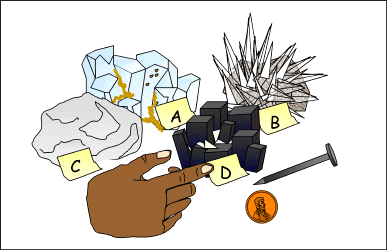4th Grade Performance Task
Contributed by: Council of Chief State School Officers (CCSSO/SCASS)
Description:
This event assesses the students' abilities to formulate and apply
rules that they can use to compare and rank things. The specific
subject is the hardness and softness of minerals. It asks them to
perform a scratch test on four unknown mineral samples, read a bar
graph that illustrates the comparative hardness and softness of
four named minerals, then combine the scratch test results with
the bar graphâs information to identify the four mineral samples.
The students must already know: (1) fingernails are softer than
pennies and pennies are softer than nails; 2) harder things scratch
softer things; 3) how to read a bar graph.
Students will be working in groups of 4-6 for the experiment/activity
part of this exercise. Each student must record the information
in his or her own booklet (test papers). Allow from 20 to 25 minutes
to complete the group work, and a similar time period for students
to do their individual answers to the test questions.
Overall Task Content Area:
- Earth Science
Specific Knowledge Areas:
- Properties of Earth materials
Performance Expectations:
- conducting investigations
- using equipment
- gathering, organizing, and representing data
- formulating conclusions from investigational data
- applying scientific principles to develop explanations and solve
new problems
National Science Education Standards:
4 D ESS 1: Properties of Earth materials: Grades
K-4
1.1 Earth materials are solid rocks and soils, water, and
the gases of the atmosphere. The varied materials have different
physical and chemical properties, which make them useful in different
ways, for example, as building materials, as sources of fuel, or
for growing the plants we use as food. Earth materials provide many
of the resources that humans use.
4 A SI 1: Ability to do scientific inquiry: Grades K-4
1.4 Use data to construct a reasonable explanation. This
aspect of the standard emphasizes the students’ thinking as they
use data to formulate explanations. Even at the earliest grade levels,
students should learn what constitutes evidence and judge the merits
or strength of the data and information that will be used to make
explanations. After students propose an explanation, they will appeal
to the knowledge and evidence they obtained to support their explanations.
Students should check their explanations against scientific knowledge,
experiences, and observations of others.
(Use the "hot" link on the PALS home page to
check the full text of related National Science Education Standards,
if desired.)
National Council of Teachers of Mathematics:
AL1: Understand patterns, relations and functions:
Grades pre K-5 a. sort, classify, and order objects by size,
number, and other properties.
DAP1: Formulate questions that can
be addressed with data and collect, organize, and display relevant
data to answer them:
Grades pre K-5 e. collect data using observations,
surveys, and experiments
Grades pre K-5 f. represent data using tables and graphs
such as line plots, bar graphs, and line graphs
DAP3: Develop and evaluate inferences
and predictions that are based on data:
Grades pre K-5 b. propose and justify conclusions
and predictions that are based on data and design studies to further
investigate the conclusions or predictions
PS2: Solve problems that arise in mathematics and in
other contexts:
Grades pre K-5
CON1: Recognize and use connections among mathematical
ideas:
Grades pre K-5
REP2: Select, apply, and translate among mathematical
representations to solve problems:
Grades pre K-5
Materials for "Minerals":
At this station students should have:
- 1 penny
- 1 nail
- 1 piece of quartz (labeled "A")
- 1 piece of calcite (labeled "B")
- 1 piece of talc (labeled "C")
- 1 piece of hornblende (labeled "D")
- 1 pen or pencil
Advance Preparation:
No special advanced set-up is needed for this exercise. Each group
should be given a set of materials to work with.
Students should be ready to work as soon as the period begins. Group
assignments should be made in advance. The materials should be set
out at each lab station, if possible. A central supply area, if
needed, should be easily accessible. All supplies should be clearly
labeled.
Safety:
- Be careful.
- Teachers and students should always exercise appropriate safety
precautions and utilize appropriate laboratory safety procedures
and equipment when working on science performance tasks.
Advanced Preparation Set Up:
| Label mineral samples and prepare student work station.

|
|

